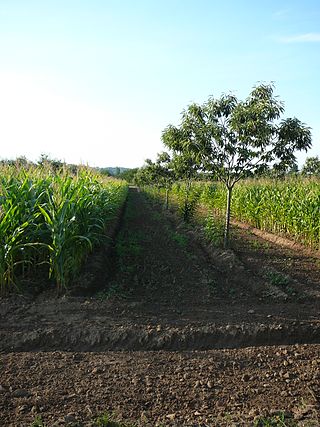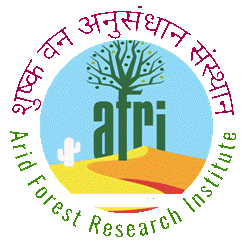
Forestry is the science and craft of creating, managing, planting, using, conserving and repairing forests and woodlands for associated resources for human and environmental benefits. Forestry is practiced in plantations and natural stands. The science of forestry has elements that belong to the biological, physical, social, political and managerial sciences. Forest management plays an essential role in the creation and modification of habitats and affects ecosystem services provisioning.

Reforestation is the practice of restoring previously existing forests and woodlands that have been destroyed or damaged. The prior forest destruction might have happened through deforestation, clearcutting or wildfires. Two important purposes of reforestation programs are for harvesting of wood or for climate change mitigation purposes. Reforestation can also help with ecosystem restoration. One method for reforestation is to establish tree plantations, also called plantation forests. They cover about 131 million ha worldwide, which is 3 percent of the global forest area and 45 percent of the total area of planted forests.

Agroforestry is a land use management system that integrates trees with crops or pasture. It combines agricultural and forestry technologies. As a polyculture system, an agroforestry system can produce timber and wood products, fruits, nuts, other edible plant products, edible mushrooms, medicinal plants, ornamental plants, animals and animal products, and other products from both domesticated and wild species.

Afforestation is the establishment of a forest or stand of trees (forestation) in an area where there was no recent tree cover. In comparison, reforestation means re-establishing forest that have either been cut down or lost due to natural causes, such as fire, storm, etc. There are three types of afforestation: Natural regeneration, agroforestry and tree plantations. Afforestation has many benefits. In the context of climate change, afforestation can be helpful for climate change mitigation through the route of carbon sequestration. Afforestation can also improve the local climate through increased rainfall and by being a barrier against high winds. The additional trees can also prevent or reduce topsoil erosion, floods and landslides. Finally, additional trees can be a habitat for wildlife, and provide employment and wood products.

Forestry laws govern activities in designated forest lands, most commonly with respect to forest management and timber harvesting. Forestry laws generally adopt management policies for public forest resources, such as multiple use and sustained yield. Forest management is split between private and public management, with public forests being sovereign property of the State. Forestry laws are now considered an international affair.
Forest management is a branch of forestry concerned with overall administrative, legal, economic, and social aspects, as well as scientific and technical aspects, such as silviculture, protection, and forest regulation. This includes management for timber, aesthetics, recreation, urban values, water, wildlife, inland and nearshore fisheries, wood products, plant genetic resources, and other forest resource values. Management objectives can be for conservation, utilisation, or a mixture of the two. Techniques include timber extraction, planting and replanting of different species, building and maintenance of roads and pathways through forests, and preventing fire.

A "Common Important Forest" in India is a forest governed by local communities in a way compatible with sustainable development. Such forests are typically called village forests or panchayat forests, reflecting the fact that the administration and resource use of the forest occurs at the village and panchayat levels. Hamlets, villages and communities of villages may actually administer such a forest. Such community forests are usually administered by a locally elected body, usually called the Forest Protection Committee, Village Forest Committee or the Village Forest Institution. Such committees are known as Van Panchayats in the Kumaon Division of Uttarakhand, Forest Co-operative Societies in Himachal Pradesh and Van Samrakshan Samitis in Andhra Pradesh. Legislation pertaining to communal forests vary from state to state, but typically the state government retains some administrative control over matters like staff appointment, and penalization of offenders. Such forests typically conform to the IUCN Category VI Protected Areas, but protection may be enforced by the local communities or the government depending on local legislation. Maharashtra is the state with the most forest land while Haryana has the least.
Forest farming is the cultivation of high-value specialty crops under a forest canopy that is intentionally modified or maintained to provide shade levels and habitat that favor growth and enhance production levels. Forest farming encompasses a range of cultivated systems from introducing plants into the understory of a timber stand to modifying forest stands to enhance the marketability and sustainable production of existing plants.

Deforestation in Cambodia has increased in recent years. Cambodia is one of the world's most forest endowed countries, that was not historically widely deforested. However, massive deforestation for economic development threatens its forests and ecosystems. As of 2015, the country has one of the highest rates of deforestation in the world.

Forestry in India is a significant rural industry and a major environmental resource. India is one of the ten most forest-rich countries of the world. Together, India and 9 other countries account for 67 percent of the total forest area of the world. India's forest cover grew at 0.20% annually over 1990–2000, and has grown at the rate of 0.7% per year over 2000–2010, after decades where forest degradation was a matter of serious concern.

S. M. Raju is a civil servant working for Bihar Government.

The forestry sector of Pakistan is a main source of lumber, paper, fuelwood, latex, medicine as well as food and provide ecotourism and wildlife conservation purposes. 5% of Pakistan's land is covered in forest (2024). The Shangla district is the only district of Pakistan that composed of more than 80% of forest land.
The Madhya Pradesh Rural Livelihoods Project (MPRLP) works with local village assemblies, Gram Sabha, to facilitate and guide community-driven collective and individual action to reduce poverty in the state of Madhya Pradesh, India.

Farming systems in India are strategically utilized, according to the locations where they are most suitable. The farming systems that significantly contribute to the agriculture of India are subsistence farming, organic farming, industrial farming. Regions throughout India differ in types of farming they use; some are based on horticulture, ley farming, agroforestry, and many more. Due to India's geographical location, certain parts experience different climates, thus affecting each region's agricultural productivity differently. India is very dependent on its monsoon cycle for large crop yields. India's agriculture has an extensive background which goes back to at least 9 thousand years. In India, in the alluvial plains of the Indus River in Pakistan, the old cities of Mohenjo-Daro and Harappa experienced an apparent establishment of an organized farming urban culture. That society, known as the Harappan or Indus civilization, flourished until shortly after 4000 BP; it was much more comprehensive than those of Egypt or Babylonia and appeared earlier than analogous societies in northern China. Currently, the country holds the second position in agricultural production in the world. In 2007, agriculture and other industries made up more than 16% of India's GDP. Despite the steady decline in agriculture's contribution to the country's GDP, agriculture is the biggest industry in the country and plays a key role in the socio-economic growth of the country. India is the second-largest producer of wheat, rice, cotton, sugarcane, silk, groundnuts, and dozens more. It is also the second biggest harvester of vegetables and fruit, representing 8.6% and 10.9% of overall production, respectively. The major fruits produced by India are mangoes, papayas, sapota, and bananas. India also has the biggest number of livestock in the world, holding 281 million. In 2008, the country housed the second largest number of cattle in the world with 175 million.
Indira Priyadarshini Vriksha Mitra Awards or IPVM Awards are given by Ministry of Environment and Forests of Government of India to individuals and institutions who have done pioneering and exemplary work in the field of afforestation and wasteland development. A cash award of Rupees Two lakh fifty thousand is presented to individuals/institutions in seven categories. It was instituted in 1986 and were given annually. Initially, IPVM awards were given in twelve categories till 2006. But as per 2012 notification of Ministry of Environment and Forests Seven Categories are approved for IPVM Awards.

Arid Forest Research Institute (ICFRE-AFRI) is a research institute situated in Jodhpur, Rajasthan, India. The institute conducts scientific research in forestry in order to provide technologies to increase the vegetative cover and to conserve biodiversity in the hot arid and semi-arid regions of Rajasthan and Gujarat. It helps to provide data and information to prevent and mitigate water scarcity related problems which affect the environment and people.It operates under the Indian Council of Forestry Research and Education (ICFRE) of the Ministry of Environment and Forests, Government of India.
Van Vigyan Kendra (VVK) or Forest Science Centres (FSC) has been established by Indian Council of Forestry Research and Education (ICFRE) of the Ministry of Environment and Forests, Govt. of India. It intends to help disseminate various technologies developed by farmers, forest based industries and forest research institutes.
Telangana Ku Haritha Hāram is the afforestation program undertaken by the Telangana government. Haritaharam 2015 was officially inaugurated by ex Telangana State Chief Minister Kalvakuntla Chandrasekhar Rao on 3 July 2015 at Chilukur Balaji Temple. The Telangana Government has designed this program with the objective of planting trees and greening the whole of Telangana. 46 crore saplings were planted in 2016 alone.

Compensatory Afforestation (CA) is defined as the process of afforestation, and associated regeneration activities are done to compensate for destroyed forest land that has been diverted to non-forest activities. In this context, non-forest activities mean the clearing of a forest or just a small part for the following purposes: Coffee cultivation, rubber, tea, plants with oil, medicinal plants or gardening crops. This may be for the purpose of personal use or for business use—or any other purpose other than the reforestation of the forest.
The National Agroforestry Policy of India is a comprehensive policy framework designed to improve agricultural livelihoods by maximizing agricultural productivity for mitigating climate change. The Government of India launched the policy in February 2014 during the World Congress on Agroforestry, held in Delhi. India became the first country in the world to adopt an agroforestry policy.












